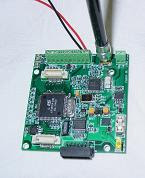
Sunday, January 13, 2008
Wireless, ad hoc sensor networks (WSNs) differ from the more commonly seen sensor networks in that they offer more than automated data collection and monitoring of systems.
Fleck circuitboardCSIRO has designed and developed a durable, yet versatile device capable of sensing, computation, actuation and wireless communications. These devices, known as "Flecks", consist of a low power CPU with additional off-chip flash memory and a radio transceiver. Each Fleck has the capacity for sensor boards to be connected, however, some sensors such as temperature and charge current are built into the base platform as standard.
CSIRO's Flecks run the Berkley TinyOS operating system (with programs built using NesC) on the Atmega128L microprocessor, making them functionality similar to other MOTES such as Crossbow's MICA series. Fleck's utilise the Nordic nRF903 transceiver for communications achieving ranges up to 500m in open outdoor environments.
There are many technical and theoretical issues to address in realising a network of devices that sense the environment, share information with other devices through wireless communications, formulate group decisions and instigate useful actions while managing energy through energy harvesting from the environment and minimising energy expenditure where possible.
To research these various issues large Fleck networks are being deployed to create a number of real-world experimental testbeds. While these short term experiments will focus on applications to enhance Australian agricultural and telecommunications industries, it is envisaged that such research will be applicable to many other applications.
Posted by senathk at URL: http://senathk.blogspot.com/